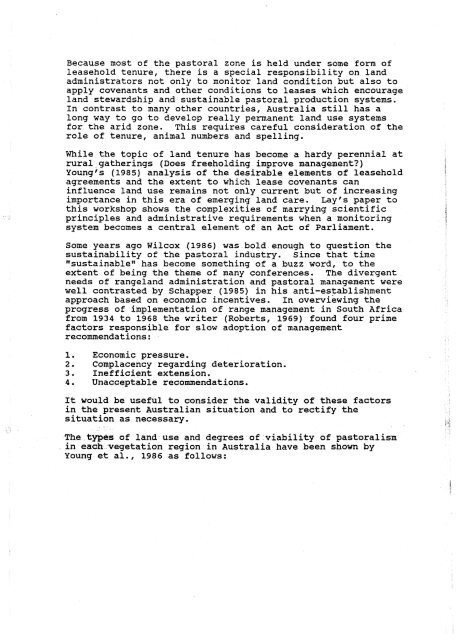soil-conservation-people-religion-and-land.pdf - South West NRM
soil-conservation-people-religion-and-land.pdf - South West NRM
soil-conservation-people-religion-and-land.pdf - South West NRM
You also want an ePaper? Increase the reach of your titles
YUMPU automatically turns print PDFs into web optimized ePapers that Google loves.
Because most of the pastoral zone is held under some form of<br />
leasehold tenure, there is a special responsibility on l<strong>and</strong><br />
administrators not only to monitor l<strong>and</strong> condition but also to<br />
apply covenants <strong>and</strong> other conditions to leases which encourage<br />
l<strong>and</strong> stewardship <strong>and</strong> sustainable pastoral production systems.<br />
In contrast to many other countries, Australia still has a<br />
long way to go to develop really permanent l<strong>and</strong> use systems<br />
for the arid zone. This requires careful consideration of the<br />
role of tenure, animal numbers <strong>and</strong> spelling.<br />
While the topic of l<strong>and</strong> tenure has become a hardy perennial at<br />
rural.gatherings (Does freeholding improve management?)<br />
Young's (1985) analysis of the desirable elements of leasehold<br />
agreements <strong>and</strong> the extent to which lease covenants can<br />
influence l<strong>and</strong> use remains not only current but of increasing<br />
importance in this era of emerging l<strong>and</strong> care. Lay's paper to<br />
this workshop shows the complexities of marrying scientific<br />
principles <strong>and</strong> administrative requirements when a monitoring<br />
system becomes a central element of an Act of Parliament.<br />
Some years ago Wilcox (1986) was bold enough to question the<br />
sustainability of the pastoral industry. Since that time<br />
lvsustainablelv has become something of a buzz word, to the<br />
extent of being the theme of many conferences. The divergent<br />
needs of rangel<strong>and</strong> administration <strong>and</strong> pastoral management were<br />
well contrasted by Schapper (1985) in his anti-establishment<br />
approach based on economic incentives. In ovenriewing the<br />
progress of implementation of range management in <strong>South</strong> Africa<br />
from 1934 to 1968 the writer (Roberts, 1969) found four prime<br />
factors responsible for slow adoption of management<br />
recommendations:<br />
1. Economic pressure.<br />
2. Complacency regarding deterioration.<br />
3. Inefficient extension.<br />
4. Unacceptable recommendations.<br />
It would be useful to consider the validity of these factors<br />
in the present Australian situation <strong>and</strong> to rectify the<br />
situation as necessary.<br />
The types of l<strong>and</strong> use <strong>and</strong> degrees of viability of pastoralism<br />
.in each.vegetation region in Australia have been shown by<br />
Young et al., 1986 as follows:
















